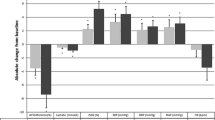Abstract
Background
The mechanism of brain death-induced myocardial dysfunction remains debatable. Hypocalcemia is known to induce reversible myocardial dysfunction. However, the incidence of hypocalcemia and its effect on myocardial function during brain death is unknown.
Methods
In 54 consecutive braindead patients, we measured plasma total and ionized calcium concentrations, QT and corrected QT intervals, and left ventricular ejection fraction area (LVEFa), using transesophageal echocardiography.
Results
49 (91%) of brain-dead patients had a decrease in total plasma total calcium concentration but only 19 (35%) had a decrease in plasma ionized calcium. Corrected total plasma calcium failed to predict ionized calcium concentration and QT intervals were not significantly different in normo and hypocalcemic patients. The LVEFa was not significantly different between normo and hypocalcemic patients (53±13 versus 50±20%), and no correlation was found between LVEFa and ionized calcium (R=0.02, NS). Hypocalcemic patients required greater doses of dopamine (8.2±5.2 versus 5.0±3.4 μg·kg−·min−1,p<0.02) to maintain arterial pressure. Hypocalcemia was associated with a higher volume loading and a lower plasma protide concentration which reflected hemodilution.
Conclusion
A decrease in plasma ionized calcium is not frequent, rarely severe, and probably not the main mechanism of myocardial dysfunction in brain-dead patients. Hypocalcemic patients required higher doses of dopamine, suggesting a decrease in systemic resistance. Only direct measurement of ionized calcium can assess plasma calcium ion status in brain-dead patients.
Similar content being viewed by others
References
Novitzky D, Wicomb WN, Cooper DKC, Rose AG, Fraser RC, Barnard CN (1984) Electrocardiographic, haemodynamic and endocrine changes occurring during experimental brain death in the Chacma baboon. J Heart Transplant 4:63–69
Novitzky D, Rose AG, Cooper DKC (1988) Injury of myocardial conduction tissue and coronary artery smooth muscle following brain-death in the baboon. Transplantation 45:964–966
Galinanes M, Hearse DJ (1992) Brain death-induced impairment of cardiac contractile performance can be reversed by explantation and may not preclude the use of hearts for transplantation. Circ Res 71:1213–1219
Darracott-Cankovic S, Stovin PGI, Wheeldon D, Wallwork J, Wells F, English TAH (1989) Effect of donor heart damage on survival after transplantation. Eur J Cardiothorac Surg 3: 525–532
Pilati CF, Bosso FJ, Maron MB (1992) Factors involved in left ventricular dysfunction after massive sympathetic activation. Am J Physiol 263: H784-H791
Novitsky D, Wicomb WN, Cooper DKC, Rose AG, Fraser RC, Reichart B (1987) Pathophysiology of pulmonary edema following experimental brain death in the Chacma baboon. Ann Thorac Surg 43:294–298
Bolli R (1990) Mechanism of myocardial “stunning”. Circulation 82:723–738
Novitzky D, Cooper DKC, Morrell D, Isaacs S (1988) Change from aerobic to anaerobic metabolism after brain death, and reversal following triiodothyronine therapy. Transplantation 45: 32–36
Howlett TA, Keogh AM, Perry L, Touzel R, Rees LH (1989) Anterior and posterior pituitary function in brainstem-dead donors. Translantation 47: 828–834
Zaloga GP, Chernow B (1986) Hypocalcemia in critical illness. JAMA 256:1924–1929
Desai TK, Carlson RW, Geheb MA (1988) Prevalence and clinical implications of hypocalcemia in acutely ill patients in a medical intensive care setting. Am J Med 84:209–214
Drop LJ (1985) Ionized calcium, the heart, and hemodynamic function. Anesth Analg 64:432–451
Falko JM, Bush CA, Tzagournis M, Thomas FB (1976) Congestive heart failure complicating the hungry bone syndrome. Am J Med Sci 271:85–89
Olinger GN, Hottenrott C, Mulder DG et al (1976) Acute clinical hypocalcemic myocardial depression during rapid blood transfusion and postoperative hemodialysis. J Thorac Cardiovasc Surg 72:503–511
Bazett HC (1920) An analysis of the time-relations of electrocardiogram. Heart 7:353
Bronsky D, Dubin A, Waldstein SS, Kushner DS (1961) Calcium and the electrocardiogram. Am J Cardiol 7: 823–832
Colletti RB, Pan MW, Smith EWP, Genel M (1974) Detection of hypocalcemia in susceptible neonates. The Q-oTc interval. N Engl J Med 290:931–935
Ladenson JH, Lewis JW, Boyd JC (1978) Failure of total calcium corrected for protein, albumin, and pH to correctly assess free calcium status. J Clin Endocrinol Metab 46:986–993
Dent CE (1962) Some problems with hypoparathyroidism. Br Med J 2: 1419–1425
Buckley BM, Smith SCH, Heath DA, Bold AM (1983) Clinical studies on ionized calcium using the Radiometer ICA 1 analyzer. Scan J Clin Lab Invest 43 [Suppl 165]:87–92
Martin TJ, Kang Y, Robertson KM, Virji MA, Marquez JM (1990) Ionization and hemodynamic effects of calcium chloride and calcium gluconate in the absence of hepatic function. Anesthesiology 73:62–65
Folland ED, Parisi AF, Moynihan PF, Jones DR, Feldman CL, Tow DE (1979) Assessment of left ventricular ejection fraction and volumes by real-time, two dimensional echocardiography. A comparison of cineangiographic and radionuclide techniques. Circulation 60:760–766
Ringer S (1883). A further contribution regarding the influence of different constituents of blood on the contraction of the heart. J Physiol 4:29–42
Mathru M, Rooney MW, Goldberg SA, Hirsch LJ (1993) Separation of myocardial versus peripheral effects of calcium administration in normocalcemic and hypocalcemic states using pressure-volume (conductance) relationships. Anesth Analg 77:250–255
Eriksen C, Sorensen MB, Bille-Brahe NE, Skovsted P, Lunding M (1983) Hemodynamic effects of calcium chloride administered intravenously to patients with and without cardiac disease during neuroleptanaesthesia. Acta Anaesthesiol Scand 27:13–17
Alegre M, Vincent JL (1990) Dopamine dependence in hypocalcemic patients. Intensive Care Med 16:463–465
Rumancik WM, Denlinger JK, Nahrwold ML, Falk RB (1978) The QT interval and serum ionized calcium. JAMA 240:366–368
Surawicz B (1967) Relationship between electrocardiogram and electrolytes. Am Heart J 73:814–834
Guyton AC (1991) Textbook of medical physiology. Saunders, Philadelphia, pp 878–879
Krohn JS (1993) Dilutional hypocalcemia in association with dilutional hyponatremia. Anesthesiology 79: 1136–1138
Robotham JL, Takata M, Berman M, Harasawa Y (1991) Ejection fraction revisited. Anesthesiology 74:172–183
Author information
Authors and Affiliations
Rights and permissions
About this article
Cite this article
Fulgenico, J.P., Riou, B., Devilliers, C. et al. Plasma ionized calcium in brain-dead patients. Intensive Care Med 21, 832–837 (1995). https://doi.org/10.1007/BF01700967
Received:
Accepted:
Issue Date:
DOI: https://doi.org/10.1007/BF01700967




